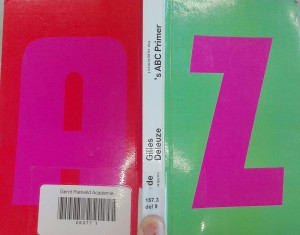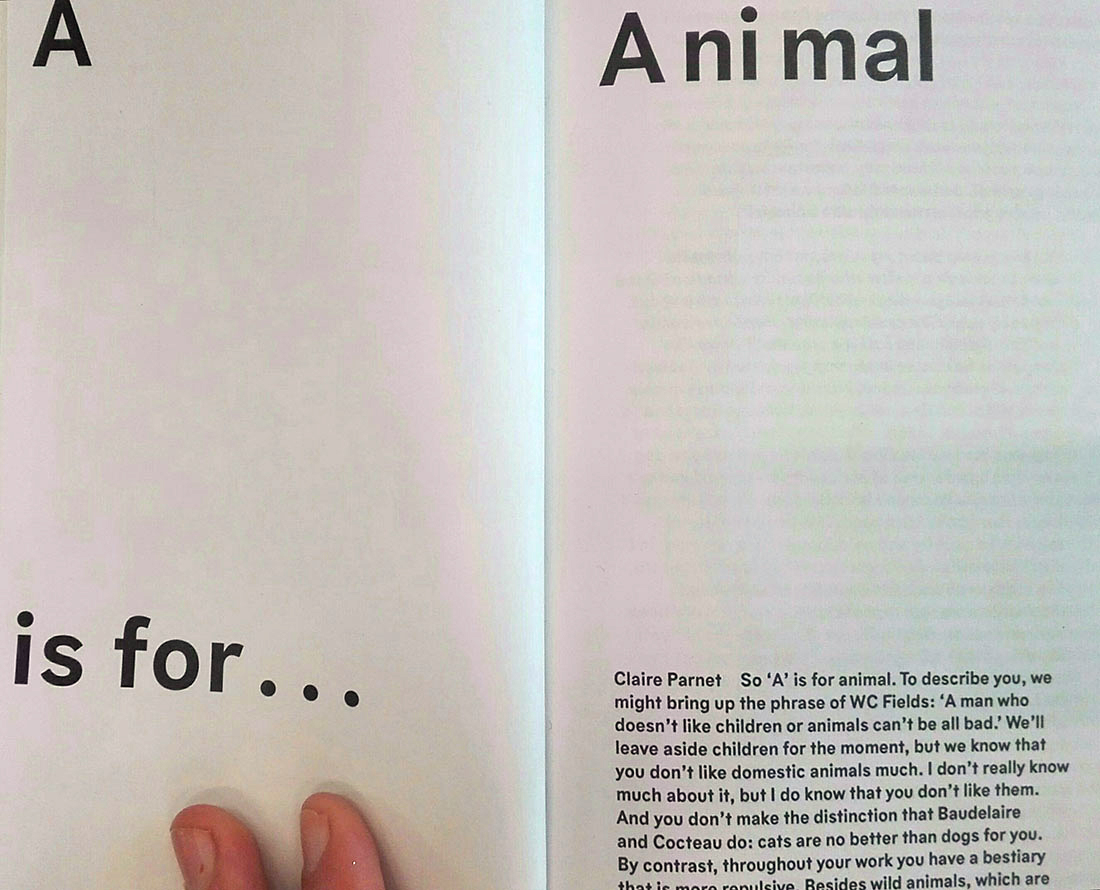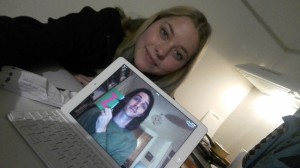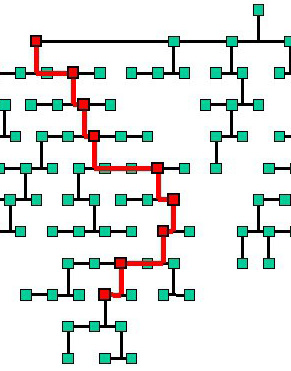“All languages are foreign.
The best books are found, not sought.
Peace, plenty, truth, and love.”
– We Have Photoshop 2017.
12/11/2017
Dear creators/members of We Have Photoshop,
First I will introduce myself; my name is Sterre, I am a Dutch student at the Gerrit Rietveld Academy in Amsterdam.
For a design research assignment called ‘Books by Design’, I am analyzing the design of your book ‘Gilles Deleuze’s ABC primer.’ I found it at our school’s library and was immediately attracted to its playfulness. The only thing that bothers me is that there’s always a grand distance between the reader and the creator, I would love to let go of that distance by having a small talk with you, that would help me understand your way of decision making.
Does We Have Photoshop also have Skype? I would love to wake up in the middle of the night for a nice conversation with you!
Let me hear what you think about it and hopefully I’ll see you soon through my computer screen.
Kind regards,
Sterre Troquay
15/11/2017
Hi Sterre –
Nice to hear from you
and sorry about the delay in getting back to you.
I’d be happy to help with your project by having a chat on Skype.
I live in London so the time difference won’t be a big deal however,
I’m currently travelling between India and Russia
and won’t be back in London until the evening of the 19th.
I’m pretty busy during the day next week
but would be happy to chat after 7pm London-time
if that isn’t too late to be of use for your project.
Monday would work well for me
but it could be a different day if that isn’t good for you.
– Mike
17/11/2017
Hi Mike,
Thank you for responding!
Monday 7 pm London time is perfect!
My username on Skype is: Sterre…...
I’m looking forward to it!
Kind regards,
Sterre
20/11/2017
Skype video call
So, you work together with other designers within the studio called ‘We Have Photoshop, right?
Yes, that’s right.
Can you tell me a bit more about the genesis of the studio?
I started the studio together with my friends from collage.
We used to study at the Yale School of Art,
though the studio was never registered as an official company.
How do you work together? Do all of you work on each project, or ..
No, as soon as we graduated from art school,
most of us moved out of Brooklyn and the group scattered a bit.
Sebastian lives in Moscow, Rebecca in Chicago,
Andrew still lives in Brooklyn and I live in London.
The distance makes it hard to work together on projects,
that’s why the studio barely exists, most of us have other primary jobs now.
Whenever we work for a client,
one of us takes the job and we sometimes help each other completing the job.
Most of the time we consult via Skype, but I sometimes go for a visit.
You designed ‘Gilles Deleuze’s ABC Primer’. Was anyone else involved in the designing of the book and was there a client that had influence on the outcome?
I designed almost the whole book.
Only the title page isn’t my idea, Sebastian worked on that.
I think there’s a clear contrast between his work and the rest of the book,
you can tell it’s been designed by someone else.
This project really originates from my own interests, there’s no client involved.
It started about 8 or 9 years ago when I found videos
of a series of interviews according to the letters of the alphabet.
They were broadcasted on French television after Deleuze committed suïcide,
I believe This was one of his conditions for taking part in the interview in the first place.
My girlfriend at that time, now wife, speaks French quite well and also works as an academic, so this subject was very interesting for her as well.
We thought: if this book doesn’t exist already,
we could make an English translation of it.
We sent an email to ask for permission to translate the interviews,
but they never responded,
so we figured that we could just do it since they’ve never said no.
My wife did the translations and the content and I did the design.
Did you know that the book was in the Rietveld library?
No, when you publish a book, you never get to know who buys it.
Nowadays that’s already different, now they do tell you in which country it’s been sold.
But we also never really wanted to publish it.
We wanted to make a translation to give it to our friends
because we thought they should read it as well.
….
I don’t really give clear answers to your questions, do I?
Yes you do .. But I also wouldn’t mind if you didn’t .. I just want to hear about everything you’ve got to say and at the end I’ll try to write a research in the same conversation-like style that the text of the book is written in. So, that’s why I’m also recording this ..
So, have you read the book then?
Yes, I’ve started on it and I really want to continue.
Yes, they have a pretty amazing conversation ..
That’s one of the reasons why we were attracted to doing this,
because the text is really good. I have read it a couple of times now,
but I can imagine it’s very hard to understand for someone
who’s not a specialist in theory.
It’s very dense, it’s very particular and specific.
They talk about a lot of different subjects as well.
Yes. The interview is structured by the letters of the alphabet,
but throughout the interview some ideas and subjects
return in the conversation they’re having.
I feel like the playful design of the book is really in contrast with its logical and chronological context. The cover of the book for instance: the letter ‘Z’ is on the front and the letter ‘A’ is on the back, shouldn’t it be the other way around? Is it a joke?
Yes, it’s definitely a joke.
But still the cover of the book makes sense: When you open it, and look at the cover,
the ‘A’ comes before the ‘Z’ and the spine serves as a space between the letters.
Can you tell me a bit more about the design of the book and the decisions you’ve made? I’m also interested in your working process.
Of course.
The design of a book really depends on the content
and I always start on the structure.
But for me, it basically means: adding, adding, adding,
and afterwards scrapping things till almost nothing’s left
and then I’ve probably done enough ..
At the time I made the book I was very interested mapping one structure onto another.
The text is made the same way: by translating the French sentences into English,
the text becomes a bit distorted at first.
The design of the book visually mirrors that.
You can see that very well on this double titled page.
Something that was also interesting for me is the running footer
which moves from ‘A’ to ‘Z’ across the bottom which makes it look like a small film.
The same thing happens with the structure of the chapters,
which are also divided by the letters of the alphabet.
What I really like about the book is that it looks very logical, but in fact it’s completely illogical. I don’t want it to be completely understandable, I like it to be a game.
Yes, that’s exactly what attracted me so much! We’re actually doing some bookbinding at school at the moment and I feel like this is very useful for my own book design as well. So, are you satisfied with the end result? Are there things you would have done differently?
Yes, I’m actually pleased with the physical design of the book.
Of course, there will always be things that you don’t like, but can’t do anything about.
The glue binding for instance:
the first version of the book was way more flexible than the latest version.
That’s because they used a lot more glue for the latest version.
I also prefer the paper of the first version, I’m not sure why they changed it ..
Thank you so much for your time and great help! I just have one more question: Would you like to take a selfie with me over Skype?
…
Gilles Deleuze’s ABC Primer, designer: We have Photoshop, Rietveld Library Cat. no: 157.3









